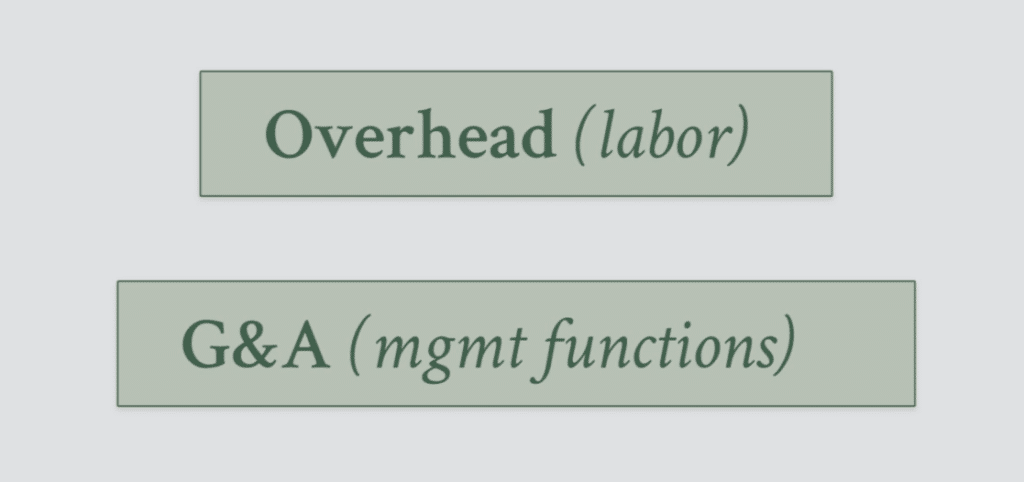How to Project an Indirect Cost Rate
How to Project an Indirect Cost Rate
We created the video above from Ed Jameson’s talk about the indirect cost rate and SBIR accounting at the National SBIR Conference. If you’re not able to watch it, here’s an overview with the key points you need to know.
What is a multiplier and how does your indirect cost rate compare to others?
Your business needs to make a profit to stay healthy and thrive. To avoid losing money because your indirect cost rate is hurting your cash flow and profitability you need to understand how the government views your “multiplier”.
Put simply – if you take a $1 in labor and add all your overhead rates and fee to it, how much do you charge the government?
Let’s say you make $80,000 a year for 2,000 hours of work; so you’re paying yourself $40 an hour. If charge a project $40 for labor, how much do you add to burden that $40 for indirect costs. $80 would be a multiplier of 2.0 ($80/$40), $120 would be a multiplier of 3.0 ($120/$40). That is your multiplier.
The “right” multiplier for Phase II SBIR funding
We’ve been doing this for over 30 years, and over that time, we’ve learned that the multiplier is different for each company and each situation—although there are some common truths.t
When we ask our DOD-funded SBIR clients who have evolved from a project into a business, and have moved out of the garage into a facility and have employees what kind of feedback they received on their multiplier (pricing), this is what we hear and how we interpret what was said:
- When their multiplier is less than 2.4, there’s no push back from their government customer about price. There’s no “Oh my God, it’s how much?” We conclude that the government sees them as INEXPENSIVE.
- At a multiplier of 2.4 to 2.7, there’s usually a normal business conversation about cost and pricing, expectation for performance, and so on. There are some questions about specific costs, but ultimately we’re in a NORMAL range.
- At a multiplier of 2.7 to 3.0, our clients start to hear things like, “Wow, you guys are EXPENSIVE, so this better work.”
- And generally, at a multiplier of greater than 3.0, the government stops doing business with them. However…
When it comes to multipliers for SBIR Phase II funding, there are outliers.
For instance, we have a client whose multiplier is 3.4 and the federal government has no problem with them whatsoever because what they do is so leading edge. They have so much intellectual property and mojo, and the government knows they can’t buy what our client sells anywhere else. So the government pays 3.4 x labor costs for it.
They’re an outlier, but they’re competing against you for SBIR Phase II funding. As contractor or grantee, you’re all competing against one another at some level, right?
Indirect cost rates methodologies
The beauty of the multiplier is it’s easy to calculate regardless of the myriad number of indirect cost rate methodologies. Here are some common ways:
Single-tiered indirect rate

When you fill out a proposal, this is the simplest way. You’ve got direct labor, overhead, materials, subtotal, fee, total price, right? So, I take all my indirect expenses and I divide by direct labor. That’s a single-tiered rate, one pool, one tier. This works great for software companies and companies who have no direct costs other than labor to burden.
Two-tiered indirect rate – an overhead and a G & A rate.

Why would you have both? Because you have two kinds of labor to burden – expensive engineers and less expensive administrative types. The denominator for engineering overhead is direct labor, so when you have expensive engineers work on your innovation, their labor is burdened with engineering overhead for a rate of x. But you may also have a separate G & A rate for your administrative people who handle subcontractors, materials, travel, and the like.
How you pool your expenses can change the appearance of your indirect rate – and your ability to better compete for SBIR Phase II funding because you want to distribute your indirect expenses towards the direct costs that your customer sees as valuable.
The goal is to set up indirect cost pools that most appropriately benefit your business. Again, nothing is set in stone; it is unique to your innovation, your business. If you’re a manufacturing company, there’s lots of stuff going through the facility. If you’re an engineering firm, it’s the people who drive the expenses, right?
NIH grants – Fringe and F&A rates
NIH pools costs differently. What we see as normal for our grantees’ fringe rates tend to be between 28-35%.
Location can also drive your rate. Our San Francisco clients are competing against companies like Google for labor so whatever you have to do to get the people to come work for you, you have to do. Google picks them up on a bus, takes care of their dry cleaning and feeds them, so you need to be competitive – right? In San Francisco, F&A rate ranging from 60-70% aren’t unusual.
Growth should drive efficiencies
As you get bigger, the government expects your indirect rates to go down unless you’re making something that’s incredibly cutting edge. There are economies of scale that kick in as you grow. For instance, you don’t need 12 more accountants because you’re doing $20 million in revenue.
Get the help you need with your F & A rate or indirect cost rate.
At Jameson & Company, we are experts at helping our clients propose the right indirect cost rate, and we’ll even help you negotiate it. What’s more, through JamesonWorx, we offer an innovative SBIR-compliant accounting system that tracks your indirect rates to help eliminate surprises and pitfalls.
Ready to Get Started? Speak With A Government Funding Award Expert!
Call Now: 781-862-5170 – or – Schedule A Call
Learn more about our free indirect cost rate projection template and free cost proposal service!
Learn more about JamesonWorx Solutions.
This is the second of a five-part series about indirect cost rates.

I’ve been in practice for over 40 years helping our small business clients procure, manage, and survive audits on more than $6 billion in federal government contract and grant funding. We’ve been featured presenters and panel moderators at Tech Connect’s National SBIR/STTR conferences since 2010, and I’ve presented at the DOD’s Mentor Protégé Summit and present regularly for several state and local organizations.
GET THE SOLUTION YOU NEED NOW
Learn more about how we can support your needs and objectives. Join us for an enlightening discussion and take the first step towards a partnership that can make a difference.
JOIN OUR NEXT WEBINAR
Join us for an upcoming webinar where we’ll dive deep into the latest insights and strategies.
Reserve your spot today and take a step toward gaining valuable knowledge that can make a real impact.
